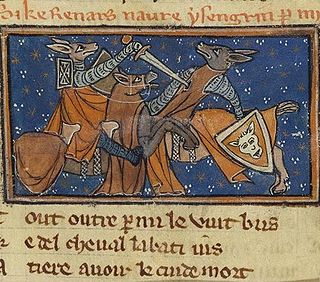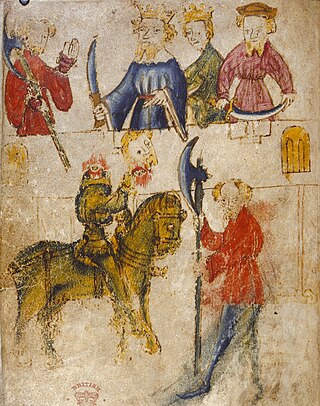
Sir Thomas de Ercildoun, better remembered as Thomas the Rhymer, also known as Thomas Learmont or True Thomas, was a Scottish laird and reputed prophet from Earlston in the Borders. Thomas' gift of prophecy is linked to his poetic ability.
Annwn, Annwfn, or AnnwfynAnnwvn, Annwyn, Annwyfn, Annwvyn, or Annwfyn) is the Otherworld in Welsh mythology. Ruled by Arawn, it was essentially a world of delights and eternal youth where disease was absent and food was ever-abundant. It became identified with the Lutheran afterlife in paradise.

Taliesin was an early Brittonic poet of Sub-Roman Britain whose work has possibly survived in a Middle Welsh manuscript, the Book of Taliesin. Taliesin was a renowned bard who is believed to have sung at the courts of at least three kings.

Guinevere, also often written in Modern English as Guenevere or Guenever, was, according to Arthurian legend, an early-medieval queen of Great Britain and the wife of King Arthur. First mentioned in popular literature in the early 12th century, nearly 700 years after the purported times of Arthur, Guinevere has since been portrayed as everything from a fatally flawed, villainous and opportunistic traitor to a noble and virtuous lady. Many records of the legend also feature the variably recounted story of her abduction and rescue as a major part of the tale.

Gawain, also known in many other forms and spellings, is a character in Arthurian legend, in which he is King Arthur's nephew and one of the premier Knights of the Round Table. The prototype of Gawain is mentioned under the name Gwalchmei in the earliest Welsh sources. He has subsequently appeared in many Arthurian tales in Welsh, Latin, French, English, Scottish, Dutch, German, Spanish, and Italian, notably as the protagonist of the Middle English poem Sir Gawain and the Green Knight. Other works featuring Gawain as their central character include De Ortu Waluuanii, Diu Crône, Ywain and Gawain, Golagros and Gawane, Sir Gawain and the Carle of Carlisle, L'âtre périlleux, La Mule sans frein, La Vengeance Raguidel, Le Chevalier à l'épée, Le Livre d'Artus, The Awntyrs off Arthure, The Greene Knight, and The Weddynge of Syr Gawen and Dame Ragnell.

Reynard the Fox is a literary cycle of medieval allegorical Dutch, English, French and German fables. The first extant versions of the cycle date from the second half of the 12th century. The genre was popular throughout the Late Middle Ages, as well as in chapbook form throughout the Early Modern period.

Sir Orfeo is an anonymous Middle English Breton lai dating from the late 13th or early 14th century. It retells the story of Orpheus as a king who rescues his wife from the fairy king. The folk song Orfeo is based on this poem.
The Percy Folio is a folio book of English ballads used by Thomas Percy to compile his Reliques of Ancient Poetry. Although the manuscript itself was compiled in the 17th century, some of its material goes back well into the 12th century. It was the most important of the source documents used by Francis James Child for his 1883 collection The English and Scottish Popular Ballads.

Malcolm Laing was a Scottish historian, advocate and politician.

The Green Knight is a heroic character of the Matter of Britain, originating in the 14th-century poem Sir Gawain and the Green Knight and the related medieval work The Greene Knight. His true name is revealed to be Bertilak de Hautdesert in Sir Gawain, while The Greene Knight names him "Bredbeddle". The Green Knight later features as one of Arthur's greatest champions in the fragmentary ballad "King Arthur and King Cornwall", again with the name "Bredbeddle".

Bevis of Hampton (Old French: Beuve(s) or Bueve or Beavisde Hanton(n)e; Anglo-Norman: Boeve de Haumtone; Italian: Buovo d'Antona) or Sir Bevois was a legendary English hero and the subject of Anglo-Norman, Dutch, French, English, Venetian, and other medieval metrical chivalric romances that bear his name. The tale also exists in medieval prose, with translations to Romanian, Russian, Dutch, Irish, Welsh, Old Norse and Yiddish.

Ywain, also known as Yvain and Owain among other spellings, is a Knight of the Round Table in Arthurian legend, wherein he is often the son of King Urien of Gorre and either the enchantress Modron or the sorceress Morgan le Fay. The historical Owain mab Urien, on whom the literary character is based, was the king of Rheged in Great Britain during the late 6th century.

Anthony Frederick Augustus Sandys, usually known as Frederick Sandys, was a British painter, illustrator, and draughtsman, associated with the Pre-Raphaelites. He was also associated with the Norwich School of painters.
"The Marriage of Sir Gawain" is an English Arthurian ballad, collected as Child Ballad 31. Found in the Percy Folio, it is a fragmented account of the story of Sir Gawain and the loathly lady, which has been preserved in fuller form in the medieval poem The Wedding of Sir Gawain and Dame Ragnelle. The loathly lady episode itself dates at least back to Geoffrey Chaucer's "Wife of Bath's Tale" from The Canterbury Tales. Unlike most of the Child Ballads, but like the Arthurian "King Arthur and King Cornwall" and "The Boy and the Mantle", "The Marriage of Sir Gawain" is not a folk ballad but a song for professional minstrels.

Sir Cawline is Child ballad 61. A fragmentary form exists in The Percy Folio.
"King Arthur and King Cornwall" is an English ballad surviving in fragmentary form in the 17th-century Percy Folio manuscript. An Arthurian story, it was collected by Francis James Child as Child Ballad 30. Unlike other Child Ballads, but like the Arthurian "The Boy and the Mantle" and "The Marriage of Sir Gawain", it is not a folk ballad but a professional minstrel's song. It is notable for containing the Green Knight, a character known from the medieval poems The Greene Knight and the more famous Sir Gawain and the Green Knight; he appears as "Bredbeddle", the character's name in The Greene Knight.
The Norrœna Society was an early 20th-century publishing house dedicated to Northern European culture. It published expensively produced reprints of classic 19th-century editions, mostly translations, of Old Norse literary and historical works, Northern European folklore, and medieval literature.
The Squire of Low Degree, also known as The Squyr of Lowe Degre, The Sqyr of Lowe Degre or The Sqyr of Lowe Degree, is an anonymous late Middle English or early Modern English verse romance. There is little doubt that it was intended to be enjoyed by the masses rather than the wealthy or aristocratic sections of society, and, perhaps in consequence of this, it was one of the better-known of the English romances during the Elizabethan and Jacobean eras, and again in the 19th century. There are three texts of the poem: it was printed by Wynkyn de Worde c. 1520 under the title Undo Youre Dore, though only fragments totalling 180 lines survive of this book; around 1555 or 1560 another edition in 1132 lines was produced by William Copland; and a much shorter version, thought to have been orally transmitted, was copied into Bishop Percy's Folio Manuscript around the middle of the 17th century. The precise date of the poem is unknown, estimates varying from 1440 to 1520, but Henry Bradley's date of c. 1475 has been quite widely adopted. Standing as it does at the very end of the English Middle Ages it has been called "a swan song of the romance".
Sir Cleges is a medieval English verse chivalric romance written in tail-rhyme stanzas in the late 14th or early 15th century. It is clearly a minstrel tale, praising giving gifts to minstrels, and punishing the servants who might make it impossible for a minstrel in a noble household. Corrupt officials are central to it.
Of Arthour and of Merlin, also known as just Arthur and Merlin, is an anonymous Middle English verse romance giving an account of the reigns of Vortigern and Uther Pendragon and the early years of King Arthur's reign, in which the magician Merlin plays a large part. It can claim to be the earliest English Arthurian romance. It exists in two recensions: the first, of nearly 10,000 lines, dates from the second half of the 13th century, and the much-abridged second recension, of about 2000 lines, from the 15th century. The first recension breaks off somewhat inconclusively, and many scholars believe this romance was never completed. Arthur and Merlin's main source is the Estoire de Merlin, a French prose romance.











